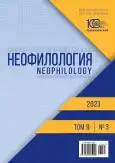Comparative analysis of international channels CGTN-English and CGTN-Russian “China Global Television Network”
- Authors: Gegelova N.S.1,2, Yuwei D.1
-
Affiliations:
- Peoples’ Friendship University of Russia named after Patrice Lumumba
- Moscow University named after A.S. Griboyedov
- Issue: Vol 9, No 3 (2023)
- Pages: 607-617
- Section: MEDIA COMMUNICATIONS AND JOURNALISM
- URL: https://journal-vniispk.ru/2587-6953/article/view/295735
- DOI: https://doi.org/10.20310/2587-6953-2023-9-3-607-617
- ID: 295735
Cite item
Full Text
Abstract
The results of a comparative analysis of English and Russian international CGTN channels are presented. The research is based on a survey of citizens and analysis of materials from the Chinese database of scientific publications CNKI and the Russian database eLibrary. The purpose of research is to study the differences between CGTN’s international communication strategies for Russian-speaking and English-speaking audiences, as well as to analyze the possibilities of China in this way to change the existing world order of information and communication. An integrated systematic approach is applied, interdisciplinary methods and techniques are used. The communication effect of CGTN work in Russian language in Russia is summarized. The work is intended for journalists, specialists in international relations, as well as relevant departments of the Russian Federation and the People’s Republic of China to analyze and improve the level of international communication through television media.
Keywords
About the authors
N. S. Gegelova
Peoples’ Friendship University of Russia named after Patrice Lumumba; Moscow University named after A.S. Griboyedov
Email: mikhail0001@mail.ru
ORCID iD: 0000-0003-1329-0169
Dr. habil. (Philology), Professor of Mass Communications Department; Professor of Theory and Practice of Journalism, Modern Media Communications Department
6 Miklukho-Maklaya St., Moscow, 117198, Russian Federation; 66A Green Ave., Moscow, 111396, Russian FederationDu Yuwei
Peoples’ Friendship University of Russia named after Patrice Lumumba
Author for correspondence.
Email: 1042228058@rudn.ru
Post-Graduate Student, Mass Communications Department
6 Miklukho-Maklaya St., Moscow, 117198, Russian FederationReferences
- Zhao Kejin. Media diplomacy and its operation mechanism. World Economy and Politics, 2004, no. 4, pp. 21-26. (In Chinese).
- Li Aike, Wu Minsu, Zhao Peng. The evolution of the world information communication order and China’s con-tribution. Modern Communication, 2018, no. 6, pp. 65-75. (In Chinese).
- Wei Xiao, Pan Pan. External communication strategy of China’s national image in the social media era – based on the analysis of China’s reports on CGTN’s overseas social media in 2017. Media, 2018, no. 10, pp. 79-81. (In Chinese).
- Wu Minsu, Liu Zijin, Wei Yuhong. External integration and dissemination of China’s current affairs news – a study based on the special report of the 2018 National “Two Sessions” on the CGTN new media terminal. TV Research, 2018, no. 6, pp. 25-28. (In Chinese).
- Jiang Heping. News communication in the age of convergent media – taking CGTN as an example. Television Research, 2017, no. 6, pp. 23-25. (In Chinese).
- Li Xueqiong. CGTN English channel development status and optimization suggestions. International Communication, 2019, no. 3, pp. 21-26. (In Chinese).
- Yin Ruyu. Creating the image of China on the CGTN page on Facebook*: results of a content analysis. Vestnik Moskovskogo universiteta. Seriya 10. Zhurnalistika = Lomonosov Journalism Journal, 2017, no. 2, pp. 51-66. (In Russ.) https://elibrary.ru/yjtvlf
- Tkacheva N.V. National media as a promotional tool of China’s soft power. Vestnik Moskovskogo universiteta. Seriya 10. Zhurnalistika = Lomonosov Journalism Journal, 2019, no. 6, pp. 94-128. (In Russ.) https://doi.org/10.30547/vestnik.journ.6.2019.94128, https://elibrary.ru/daxgku
- Podolyak D.V. Media as a soft power tool in the PRC’s foreign policy. Obshchestvo: politika, ekonomika, pravo = Society: Politics, Economics, Law, 2018, no. 11 (64), pp. 41-44. (In Russ.) https://doi.org/10.24158/pep.2018.11.8, https://elibrary.ru/younnr
- Jia Fan. Analysis of intercultural communication of TV media – taking the Russian channel of CCTV as an example. Science and Technology Communication, 2015, no. 6, pp. 51-67. (In Chinese).
- Yarnykh V.I. Brand journalism tools in the formation of the media influence model in information space. Vestnik RGGU. Seriya: Literaturovedenie. Yazykoznanie. Kul’turologiya = RGGU Bulletin. Series: Literary Theory. Linguistics. Cultural Studies, 2019, pp. 70-76. https://doi.org/10.28995/2686-7249-2019-9-70-76, https://elibrary.ru/slfcbb
- Ma Yuan: Thoughts on research on the integration and transformation of TV media and social media – based on the research reviews of domestic and foreign scholars. News and Writing, 2019, no. 5, pp. 48-51. (In Chinese).
- Liu Xiao, Dong Ziming. Imbalance and check and balance: a theoretical perspective on the operation pattern of international communication. Journal of Sichuan University (Philosophy and Social Science Edition), 2017, no. 3, pp. 73-81. (In Chinese).
Supplementary files










